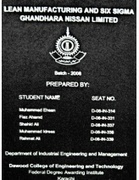Apr 19 2013
Photos of Toyota plant in San Antonio, TX | San Antonio Express
See on Scoop.it – lean manufacturing
Stretching lean’s influence San Antonio Express Hundreds of manufacturers from across the continent witnessed firsthand this week how Toyota’s assembly plant on the South Side implements the automaker’s famous approach to lean manufacturing, also…
See on www.mysanantonio.com


Apr 19 2013
A Pakistani student’s project report on the Ghandara Nissan plant
See on Scoop.it – lean manufacturing
 PROJECT REPORT ON LEAN MANUFACTURING AND SIX SIGMA AT GHANDHARA NISSAN LIMITED
PROJECT REPORT ON LEAN MANUFACTURING AND SIX SIGMA AT GHANDHARA NISSAN LIMITED
If you have always wanted to visit the Ghandara Nissan plant in Pakistan, this 170-page report is the next best thing, with numerous photographs of the shops.
The title implies that the plant practices both Lean Manufacturing and Six Sigma, but it is misleading.
It contains a long, general, and loose description of Six Sigma, but no evidence of it being used at Ghandara Nissan.
See on www.scribd.com
Share this:
Like this:
By Michel Baudin • Web scrapings 1 • Tags: Lean manufacturing, Nissan, Six Sigma